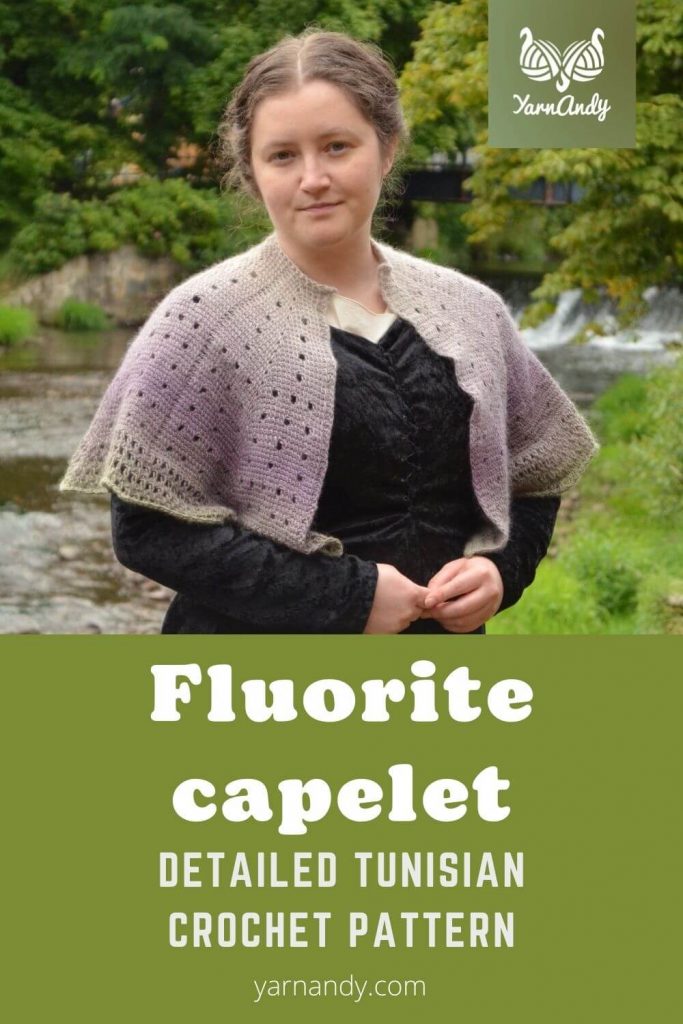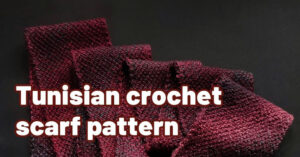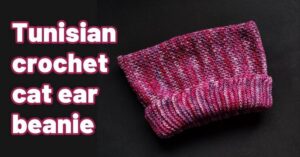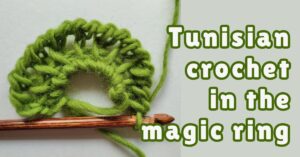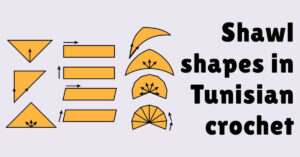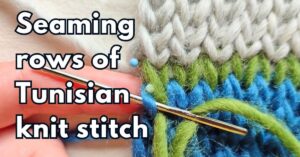Make an elegant and slightly lacy Tunisian crochet capelet for your history bounding or to wear to an important event this year, using this detailed pattern which comes with videos and charts, besides the full Tunisian crochet instructions.
Contents
About the Fluorite capelet pattern
This capelet is worked in Tunisian crochet on a cabled hook. It’s a great project for you if you like historical-inspired outfits or history bounding, or maybe are tired of the endless patterns for shawls out there and want to try something new. Something with a neckline.
Due to the shape, the capelet stays on your shoulders even when you move around. You can add a button at the neckline for extra stability when out and about in the world.
Make it in a soft wool and enjoy the warmth or make it in a light cotton to wear on chilly summer evenings.
The pattern features 10 pages of detailed instructions, a chart, and access to a video that shows you all the steps.
It has been thoroughly tested by people with different amounts of experience in Tunisian crochet. You can check out some of the testers’ projects on Ravelry, but don’t forget to get your code for 50% off.
Skill level required to make this Tunisian crochet capelet
Experienced beginner or intermediate, due to eyelets and increases made with twisted stitches.
Observations
- This pattern is worked in forward and return passes. Both are mentioned in the same row instructions.
- You only need to make the first row one way – either start with chains and simple stitches, or with FSc, which create an edge that doesn’t curl. You should not do both.
- Increases are made in the middle of the pattern repeats. Yarn overs create eyelets that are decorative; they are not increases.
- Always skip a stitch or eyelet when making yarn overs.
- When working in eyelets, you can insert the hook through the eyelet to pick up a loop or in the top of the eyelet. You choose, but be consistent. Stick to one method.
- In (round brackets) at the end of each row you have the number of loops you need to have on the hook at the end of the row, before the return pass.
- In [square brackets] you have repeat sequences.
- In {curly brackets} you have instructions that are worked in the same stitch.
- Use the chart on the last page if you prefer working from charts. Keep in mind that it only shows the pattern repeat, not the first and last stitch, plus the last eyelet on each row, nor the return passes.

Size of the Tunisian crochet capelet
The sample measures 100 cm or 40” in length and 40 cm or 16” in depth (see schematics below), with a neck opening of about 20 cm. To increase the size of the capelet, you can work with thicker yarn and larger hooks or make more rows.

Gauge swatch instructions
You will need to swatch only if you want to reach the exact dimensions listed here. The swatch consists of 7 rows of 9Tss (including the last stitch).
The resulting rectangle should be 5 cm by 5 cm or about 2 by 2 inches. If the gauge swatch is larger, you can decrease the hook size while you still have a draping swatch.
You can also stop working on the capelet earlier to reach the dimensions listed.
Materials required to make a Tunisian crochet capelet pattern
- Yarn: a fingering or DK weight yarn – between 600-800 meters; in sample: one Katia Infinity Shawl cake, colorway 300 or violet-gray, which comes in cakes of 600 meters per 150 grams. Alternatives to this yarn;
- Hook – 5 mm cabled Tunisian crochet hook or hook size that goes with your yarn; 1.5-2 mm larger than hook recommended on the label;
- Tapestry needle and scissors.
Video for the Tunisian crochet capelet pattern
This pattern comes with videos showing you how to make one pattern repeat, up to row 17, plus 3 rows of the edging and the binding off.
Here is the right-handed video for a section of the capelet.
The video comes with captions too, so you can follow along with the video and written instructions.
Left-handed video for this Tunisian crochet capelet pattern below:
Low vision version available
This pattern comes with a low vision version, which I prepared specifically for crocheters who need a specific format in order to use crochet patterns.
Here are the specifications in case you want to try out this pattern:
- the main text is written in 24 point Arial font; 28 point and bold is used for headings;
- black text on white background;
- left justified text, 1 inch margins;
- no columns;
- page numbers on the bottom left part of the page;
- no charts;
- all abbreviations are explained in the list.
If you have any feedback regarding the low vision version of this pattern, I’m always happy to receive it.
If you’d like another one of my patterns in a low vision format, please let me know which. I’m trying to go through them all, but it will take a while.
Where to get the pattern
For now, the pattern is available in my shop and on Ravelry. If you want other options, please let me know and I’ll upload the files in other shops as well.
If you want to try other Tunisian crochet patterns, check out these free patterns on the blog. They all come with PDF versions as well.
Corner to corner Tunisian crochet scarf pattern
Nordic star Tunisian crochet baby blanket pattern
Tunisian crochet cat ear beanie free pattern
Free wavy mosaic Tunisian crochet pattern
Feather and fan Tunisian crochet pattern for a washcloth
Tunisian crochet asymmetrical rounded triangle shawl tutorial
How to start a Tunisian crochet project in a magic ring
How to make different shawl shapes in Tunisian crochet
How to sew Tunisian knit stitch row to row
How to make a Tunisian crochet mosaic bee potholder
There are videos available for this pattern and more are coming soon, make sure you are subscribed to my YouTube channel if you want to know when I publish future videos.
Please subscribe to my emails also if you want to know when I publish more patterns and blog posts, to participate in testing calls, or to participate in other events where you can win free patterns or crochet supplies.
Happy crocheting for you!
Andrea

